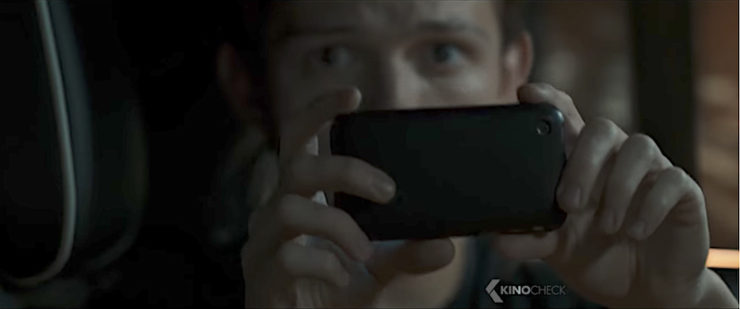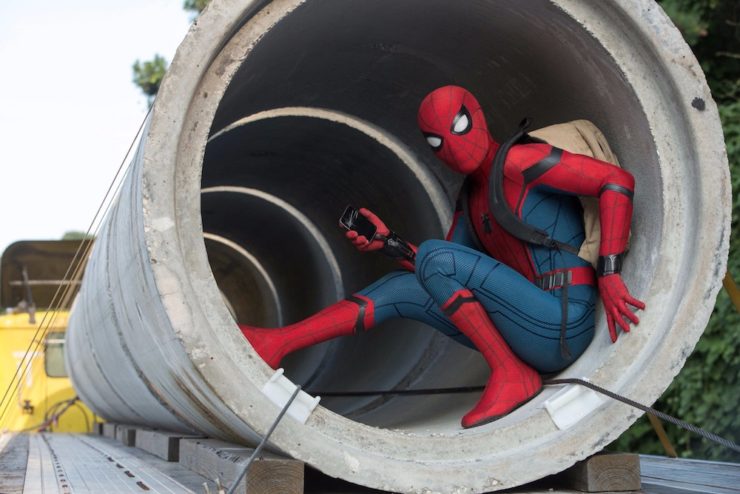From the first title card, Spider-Man: Homecoming tells you exactly what kind of story it will be—a Film by Peter Parker. The erratic, fragmented, hilarious vlog not only covers all of the ground between Civil War and this moment in the MCU in under four minutes, but it also immediately introduces a new version of our hero: Peter Parker, not reeling from the trauma of a weepy origin story or parroting Uncle Ben’s “with great power comes great responsibility” mantra, but breathlessly narrating his cannonball into the world of the Avengers.
Homecoming smartly updates one of the quintessential elements of Peter Parker’s character—his identity as a photographer—by swapping out his Canon SLR or Yashica Electro 35 for the modern teenager’s likelier choice to document their every move. This Peter Parker has the most narrative agency of any Spidey, and it’s all thanks to an outdated iPhone 3G with a cracked screen.
Peter’s relationship to his smartphone is something we haven’t seen before on screen. In the original comics (and the Raimi trilogy), Peter’s camera provides some necessary distance between himself and Spider-Man: photography helps him earn a living (albeit a scrappy one), and capturing staged photos of Spidey in action puts Peter behind the lens, granting him plausible deniability at The Daily Bugle when it comes to his alibi at various showdowns and other heroic demonstrations. The Marc Webb reboot gets closer to connecting Peter’s camera to character traits, as his decisions about what to document speak to his choices between justice and the alternative: He won’t photograph a fellow student’s humiliation at the hands of a bully, but he’ll use the camera to try and capture proof of the Lizard’s existence.

In Homecoming, Peter’s affinity has shifted from photographs to live video, which centers his story in the present and gives him more power to tell it. Instead of Peter moodily narrating his life in voiceover after the fact, this Peter eagerly documents his entry into the Avengers’ ranks in real time, complete with bonkers footage recorded while running, set in the middle of Civil War’s airport battle. Rather than witness the beginning of Peter’s legacy through his scientist father’s secret projects, viewers enter the world through Peter’s eyes, or more accurately through the lens of his smartphone camera.

There has been debate among comic book fans as to whether photography actually fits Peter’s skillset or character traits. Within the last decade, some comic arcs have reimagined adult Peter as a scientist or teacher, to actually utilize his intelligence and empathy. And the earlier Spider-Man films have flirted with giving Peter other jobs, from pizza delivery (a low point of Spider-Man 2) to an unofficial internship at Oscorp assisting Dr. Connors (in The Amazing Spider-Man). Unsurprisingly, neither of these quite jibes with the Peters of their respective films, who also wield cameras but do so in obvious nods to the character’s history, without any real emotional attachment to the act itself.
https://www.youtube.com/watch?v=xg61aQTaJGw
Homecoming removes that awkwardness by making photography no longer Peter’s job or calling, but instead a hobby, his way of letting off steam, another language and medium for self-expression. Peter’s relationship to the camera is every bit the self-aware Millennial, no different from a peer agonizing over the perfect angle for a selfie or the filter for a Snapchat: performative even in private, cultivating the image he presents to the outside world while wondering how much it matches up to how others perceive him. He opens his vlog with a faux-gritty voiceover about Queens, despite knowing the footage will never be distributed beyond that car—and that its sole audience, Happy, is sitting right there listening to him riffing. There’s no reason for Peter to infuse the video with any artifice, and yet he does; he plays around with theatricality, with spectacle. As the “director” of his video diaries, he controls the tone, whether he’s putting on an older/gruffer voice or excitedly recapping snatching Captain America’s shield in a voice of increasingly higher pitch. He decides what moments get recorded for posterity.
Which is why the reveal of Tony Stark’s “Baby Monitor” protective surveillance is so upsetting. While initially played for laughs, the sequence of Peter discovering that the Stark suit has been recording his every move for the past however many months is actually incredibly invasive. There’s something so cringeworthy about watching Peter fast-forward through the footage of him mugging for his mirrors, practicing his Spider-Man persona and voice. In Berlin, during the Civil War vlog, Peter uses his camera to take a video of his old Spider-Man suit in the mirror to psyche himself up before making his grand entrance. There’s a reason he doesn’t use his phone when fine-tuning his Stark-suited superhero alter ego; it’s a vulnerable, embarrassing process that he prefers to do in private. To discover, instead, that Tony has had invisible cameras on him the entire time takes away Peter’s agency in controlling his own narrative.

This isn’t just a matter of ego, either. Because as far as Peter is concerned, his job is to be Spider-Man. The seemingly infinite universe of high school, which is more than enough to capture most teenagers’ attentions, has shrunk for him now that he’s grappled with Ant-Man and Cap—the real Captain America, not the dorky spokesman telling kids to be cool and stay in school. If “Mr. Stark” sees him falling all over himself, he might decide he’s not fit for the job. (At least when Peter embarrassed himself interrogating Aaron Davis, with his overblown intimidation voice and eager enthusiasm, those rookie mistakes weren’t captured for posterity.) That’s why it’s imperative that Peter control the footage of himself.
But Peter has it backwards: His job right now is to be a kid. Sure, more of a teenage prodigy who occasionally dons a super suit to keep his neighborhood safe, but a kid nonetheless, who spends as much time in front of the mirror practicing asking out a pretty girl without his voice cracking as he does choosing the timbre of Spider-Man’s interrogation voice. The footage, either his video files or the Baby Monitor logs, was never meant to prove that he could or couldn’t do the job. And it’s not an alibi or a payday, not photos meant to be distributed. It’s home videos—a souvenir, a reminder that he didn’t just dream up this incredible adventure. And I hope that it continues to be a big part of the Homecoming sequel, and the rest of Spidey’s time in the Marvel Cinematic Universe.
Natalie Zutter loved so many different aspects of Homecoming—RIP all the stuff she had to cut about teen tropes and Ferris Bueller—but was especially excited to see this photography throughline. Talk Millennial superheroes with her on Twitter!










